Anyone using that page of instructions for hooking up a 1290 should be aware of a couple of things:
The output description and accompanying inductor assumes you are using a non-gapped LO2567-type transformer (the api 2503/Profile 4804 works well in this application as well!) instead of the more typical-for-this-output-stage LO1166, which is gapped for the DC. If you are using an LO1166 or Sowter or Carnhill equivalent (gapped) the inductor is unnecessary. Simply attach the primary leads to pins R (+) and T (-).
Secondly, this document suggests that Pin V and E be connected. I strongly suggest you not connect these directly, but instead, hook pin V (the module's chassis/earth) directly to the ground pin on the AC mains connector. Then, run separate wires from the AC ground pin to the chassis that your mounting the module in and another from the same AC ground pin to the +0v of the power supply. As for the module's pin E (labeled B- on Neve schematics), connect that ONLY to the +0v of the power supply.
When I originally racked my 1290's I used this instruction sheet, but experienced noise problems even at moderate gain settings. When I then changed the hookup to what I descibe above the noise went away.
If you are not working with an actual 1290 module, but instead TK's or anyone else's Neve-type PCB follow the same concept:
-Circuit board "ground" (Neve refers to this as "B-" on all their schematics) to power supply +0v
-Power supply +0v to AC connector ground pin (Neve refers to this as 'earth' which is pin V on almost all their old stuff)
-AC connector ground pin to chassis
Remember that these circuits, built as Neve intended, have the core of the transformers connected to chassis (earth). If you simply connect B- and earth signals together to one point on the chassis (as is typical of modern gear) then the current draw of the power supply (current, not voltage) is modulating through the chassis, and the transformer cores attached to the chassis. This creates noise in the audio signal.
By connecting the power supply +0v to the AC ground pin (NOT the chassis), then the shortest possible path from +0v to earth is straight down the AC cable. As long as this is the ONLY connection of B- to earth, the signal has nowhere else to go. If, however, you connect +0v to the chassis, and then attach the chassis to the AC ground pin, the current modulation of the power supply (again current, not voltage) modulates the chassis and, therefore, the transformer cores.
Yes, ultimately the two signals (B- and earth) are connected in either scenario, yet I can tell you from MUCH experimenting that one connection method (the more common one, unfortunately) creates noise while the other creates beautiful silence.
This is also true for the two-stage 1272-type circuits as well. I don't fully understand it all from a technical perspective, so I won't be able to defend my position theoretically.... just try it and you'll plainly see why Neve was so careful to connect their boxes this way.
Hope this helps all you Neve-types out there!
:thumb:
Much peace,
JC


















